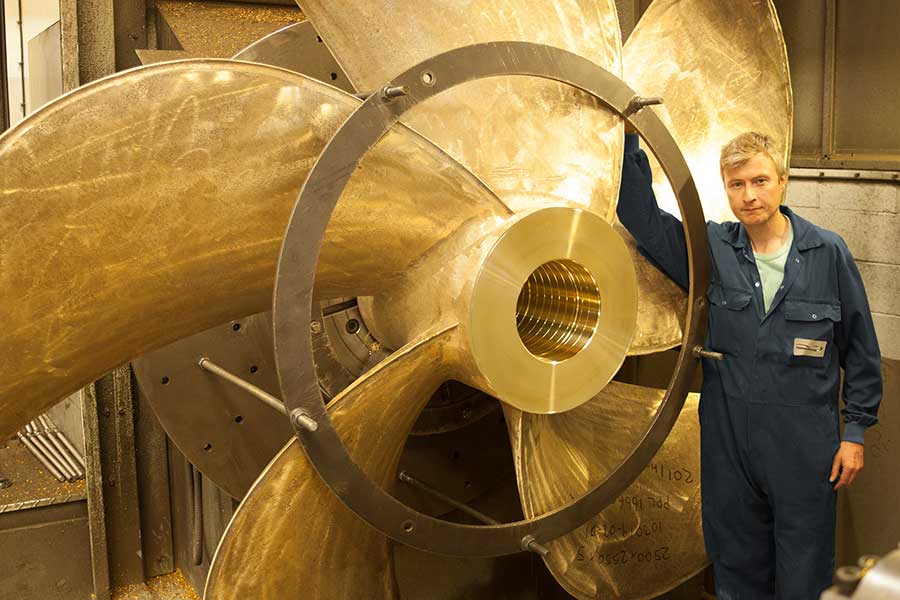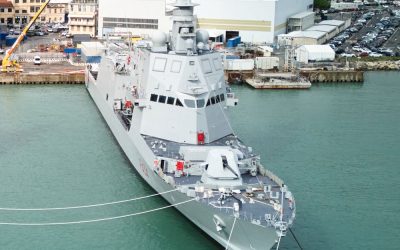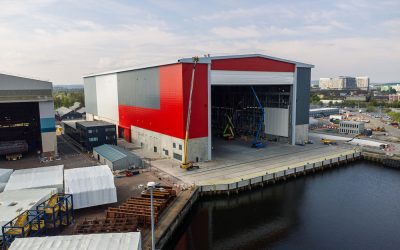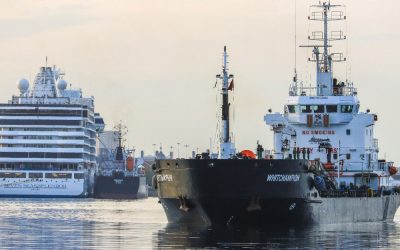CFD enables Teignbridge to optimise design and performance of propulsion systems
Founded in 1974, Teignbridge Propellers International is a world-leading designer and manufacturer of marine propulsion and stern gear products. With more than 65,000 square feet of floor space and over 100 employees at its headquarters in Southwest England, it is the largest producer of its kind in Europe. Renowned for continually optimising the performance of ships of all sizes, from yachts and patrol boats to tankers and military vessels, Teignbridge manages everything from the engine and gearbox to the back of the vessel. This includes the coupling, shaft, bearings, seals, stern tube, brackets, propellers, and rudders.
Regardless of the size of a propeller, which could be up to 8m in diameter, changing the design by just 1mm can noticeably impact both efficiency and performance. Therefore, Teignbridge uses computational fluid dynamics (CFD) simulations to not only develop the best possible designs but also ensure the highest level of manufacturing precision.
“With the latest significant investment in enhancing production precision, we’re able to build the propeller to within the accuracy of a hair,” says Mark Phare, group managing director at Teignbridge. “Now whatever the engineers design, we can replicate it perfectly in the finished product. Ensuring design and production accuracy is paramount for our business as we are acting on a global scale and we can’t fly out or keep shipping parts to fix possible issues. We need to get it right the first time, every time.”
The International Maritime Organization (IMO) and the Marine Environment Protection Committee (MEPC) set the regulations for the industry. In the past, their requirements have been guidelines but now they are becoming much more strictly enforced. IMO has put in place a strict emissions mandate to reduce CO2 output by 50% by 2050 and introduced an energy efficiency index for new designs and existing ships. It will be impossible to make this kind of significant reduction without innovations. It is vital that Teignbridge makes full use of the latest technology to stay ahead of the competition, meet all the industry regulations and build leading components that deliver optimum performance.
As Saeed Javdani, innovation and technology manager at Teignbridge, explains: “It is important for us to be on top of the game and design products with the required index, improving the product efficiency and reducing emissions.”
Harnessing the power of CFD simulations
To meet these challenges and optimise designs, Teignbridge uses Simcenter STAR-CCM+ software, with support from Maya HTT, to run fast and accurate CFD simulations that evaluate a variety of complex phenomena so the designers can understand the interaction between propulsion systems and the high-velocity water flowing across their surfaces.
Understanding cavitation – where vapour bubbles in a fluid grow and collapse due to local pressure fluctuations – allows engineers to predict the impact on propulsion performance, durability and noise. The simulations help them predict the location, extent and type of cavitation and modify designs to minimise it.
Engineers also use Simcenter STAR-CCM+ to optimise components for the entire propulsion system to ensure their influence on the water flow complements the propeller’s design. In one instance, they identified areas of low pressure on the leading edge of a rudder that could cause cavitation and noise. By redesigning the rudder and carefully aligning its leading edge to the downstream rotational flow from the propeller blades, they also managed to increase the vessels’ top speed by around 2knots.
By using computer-aided engineering (CAE) and Simcenter simulation tools, all these performance insights and improvements are made before any of the components even get wet. This allows for crucial decisions to be taken much earlier in the design process, leading to increased efficiency, reduced costs and improved products.
According to Phare, the shipbuilding industry is embracing innovation in design and manufacturing. “We see the designs are becoming much more accurate as we’re taking into account a lot more factors. With CFD simulation we’re able to predict the wake field coming into the propeller, and then how that flow can be affected by the bracket in front and the rudder behind. So we’re looking at the whole thing as a system rather than as individual items.”
Javdani says Simcenter STAR-CCM+ is vital to his team’s development processes: “You need sophisticated tools that can predict your hydrodynamic loads and how your propulsion system will behave in different operating conditions. We used to just consider one or two design points, but with Simcenter STAR-CCM+ we can predict how the vessel will perform at different speeds and in different sea conditions. Simulation makes it possible to explore many more iterations in less time so we can come up with the optimal design.”
Crucially, this technology allows engineers to consider the entire ship as a system rather than just a collection of individual components. They can place their propulsion systems inside vessels in a virtual environment to understand how they will interact. “Now we can go back to the ship designers and give them suggestions for improvements,” says Javdani. “We can explain how they can make changes to improve the flow into the propulsion system during the design stage before anything has been built. So with Simcenter STAR-CCM+ we are not only optimising the design of our components, but we’re also helping shipbuilders to achieve the maximum propulsion performance for their vessels.”






